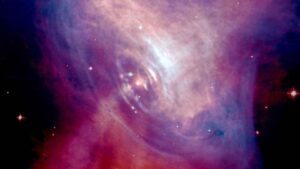
We’ve said it before and we’ll say it again: the universe is an improv artist that likes to say “Yes, and”. I really wouldn’t be surprised if the effects we see are due to both a stuff we’ll collectively call Dark Matter, as well as a modification to gravity. To prove that, however, we need to be able to make solid predictions for both how the stuff should act and how the force modification should act.
In a new paper appearing in Physical Review Letters, researchers, led by Dion Noordhuis, explain how one potential dark matter particle, the axion, should be converted into light when exposed to powerful magnetic fields. This means pulsars, with their extreme magnetic fields, are a good place to look for the light of axions ceasing to be.
The trick is, understanding what light comes from the pulsar and any surrounding material, and what light comes from axion destruction.
Researchers used the most up-to-date theoretical framework for pulsars to model what light should come from non-axion processes, and then they took very careful observations of 27 nearby pulsars to see if an axion-related excess of light could be seen. Conveniently, any excess should only shine in the radio colors of light, so it is possible to compare all the colors to find a match, and then look for a very specific excess in the radio.
And… within their error… they saw nothing. This isn’t to say axions aren’t being reduced to light in the environs of pulsars. It is only to say a whole lot of axions aren’t producing enough light for us to see it at this time.
This doesn’t rule out axions as dark matter… It just rules out axions existing in large numbers in pulsars… probably… I mean… we could have errors in pulsar models, our axion models, our dark matter models, or maybe even in our observations. What this does mean is we have something to look at, and a rabbit hole to go down as we work to precisely observe and understand our universe. We have a starting point, and that is more than we had before.
reference: Novel Constraints on Axions Produced in Pulsar Polar-Cap Cascades, Dion Noordhuis, Anirudh Prabhu, Samuel J. Witte, Alexander Y. Chen, Fábio Cruz and Christoph Weniger. Physical Review Letters 131 (2023) 111004.
